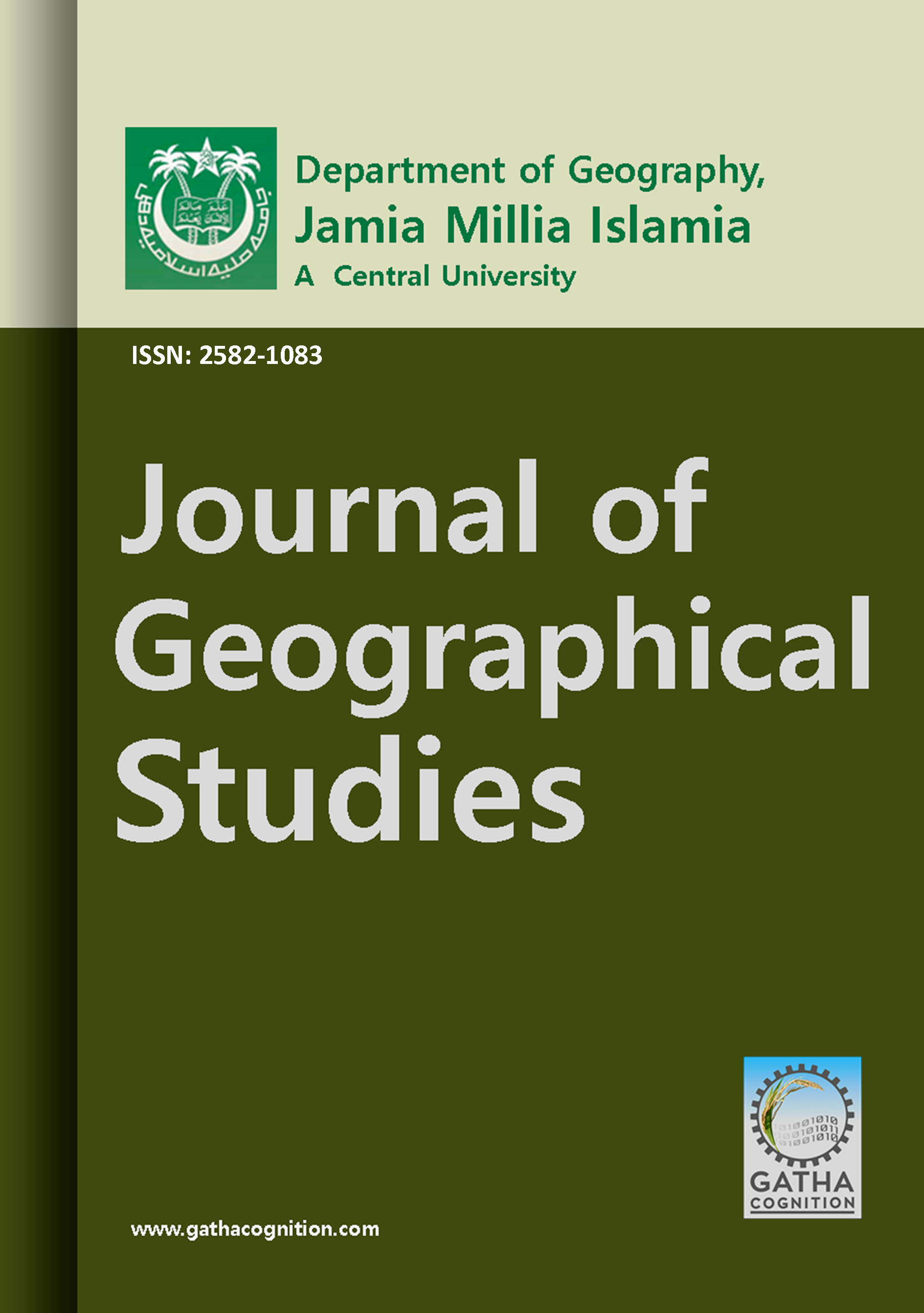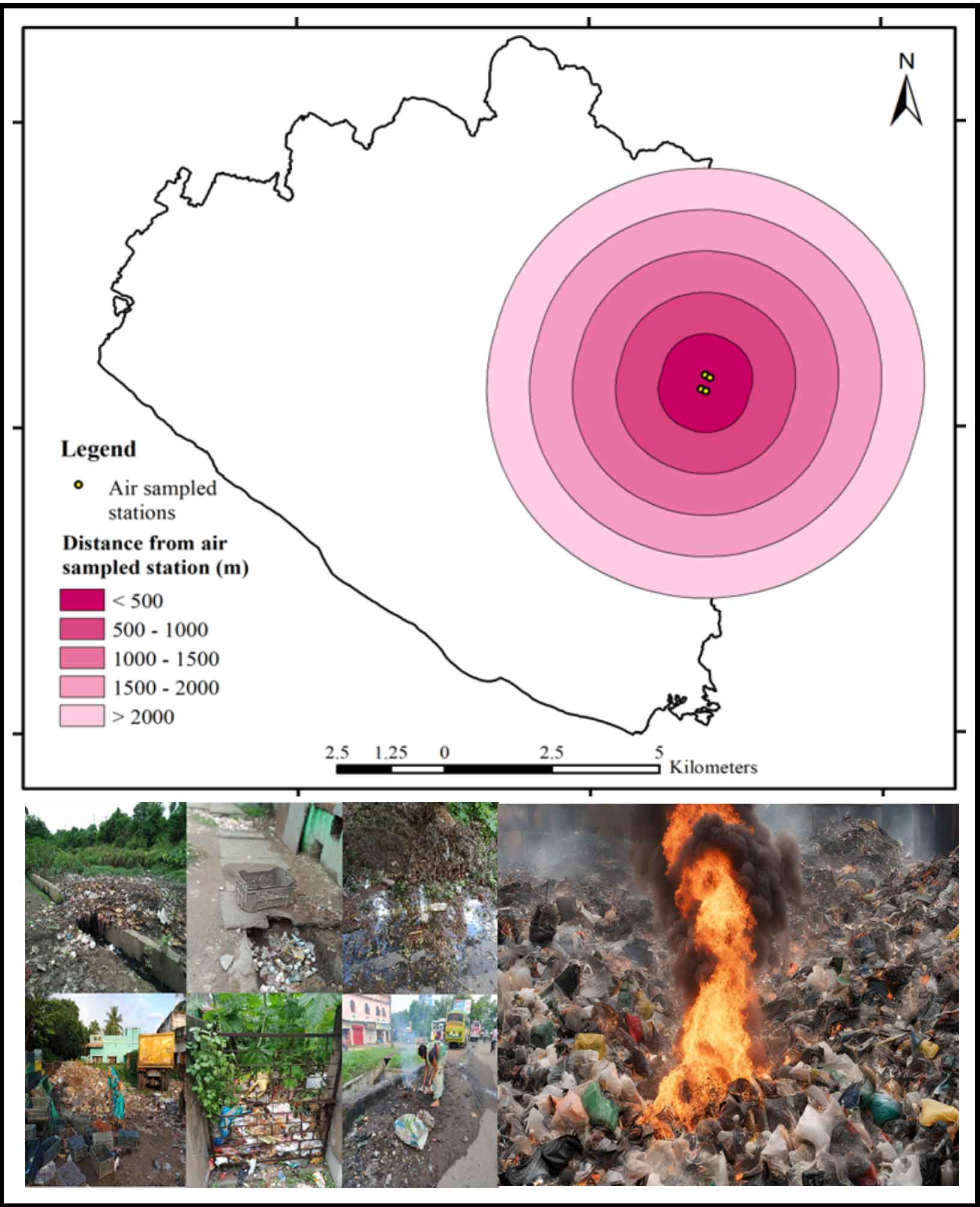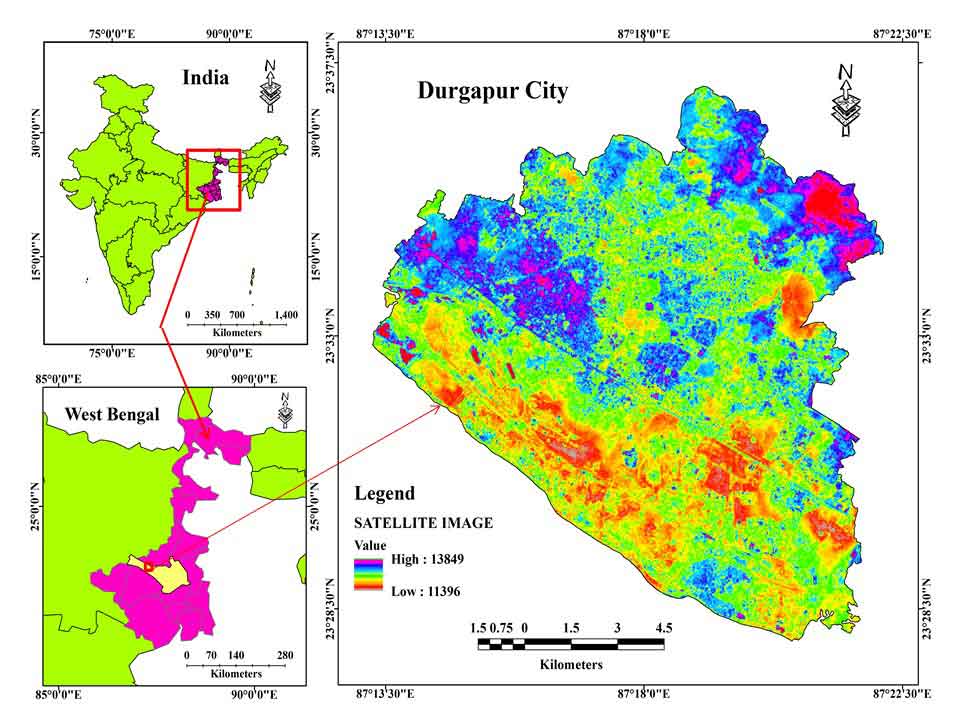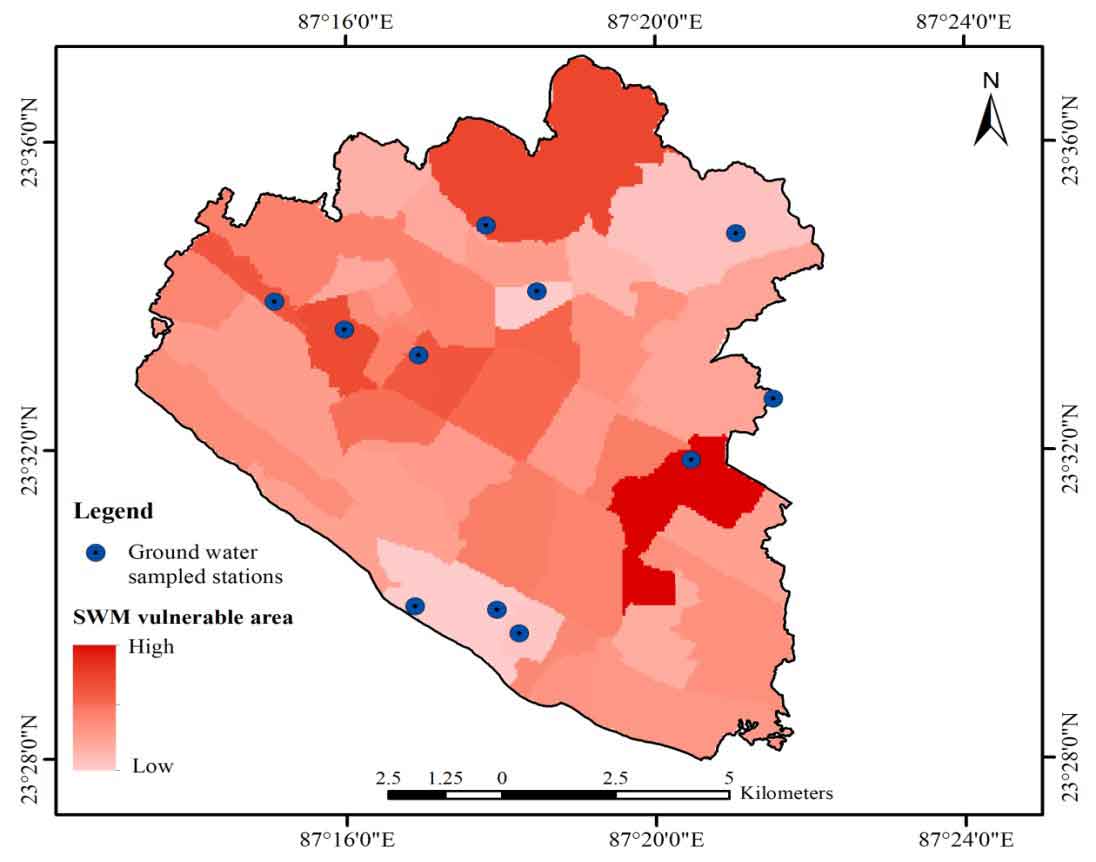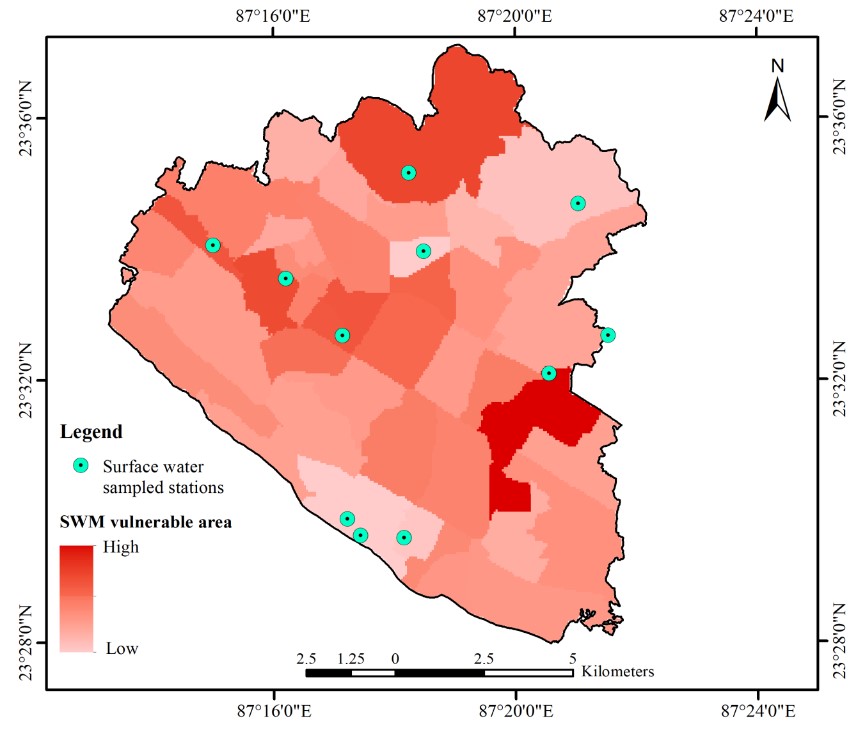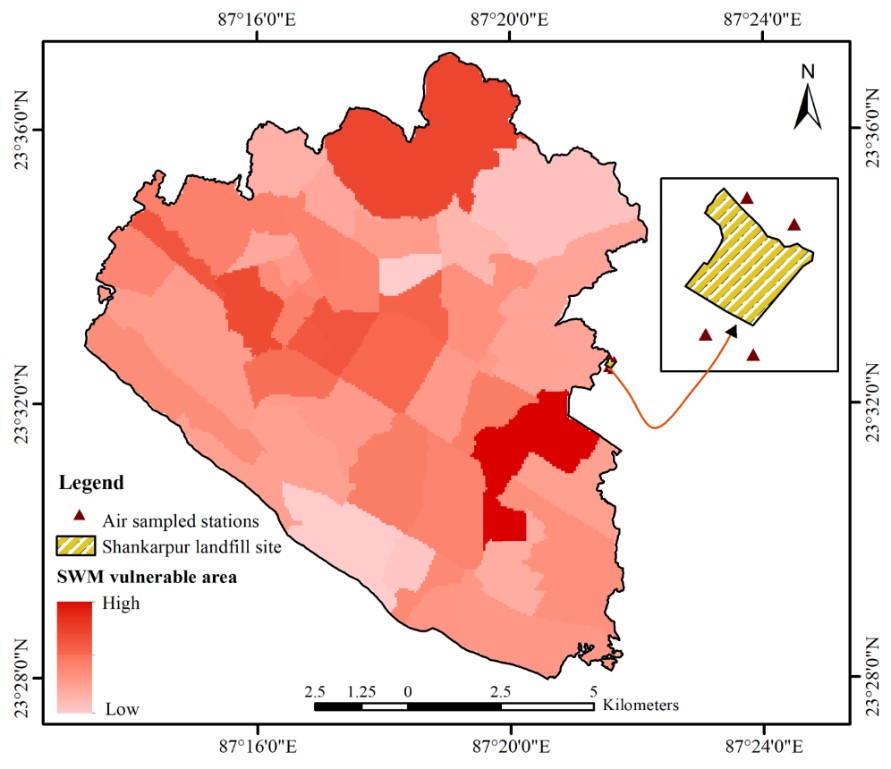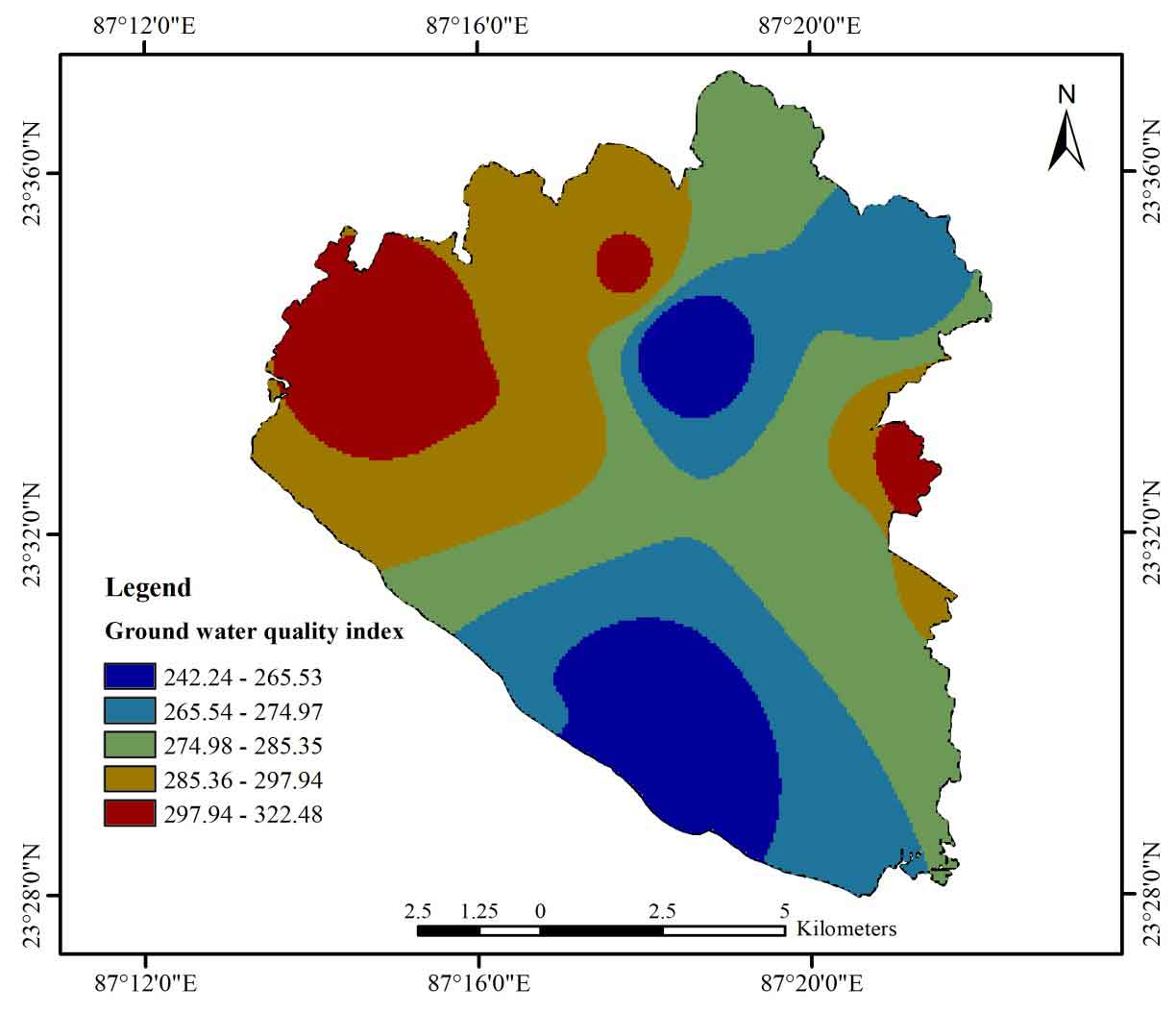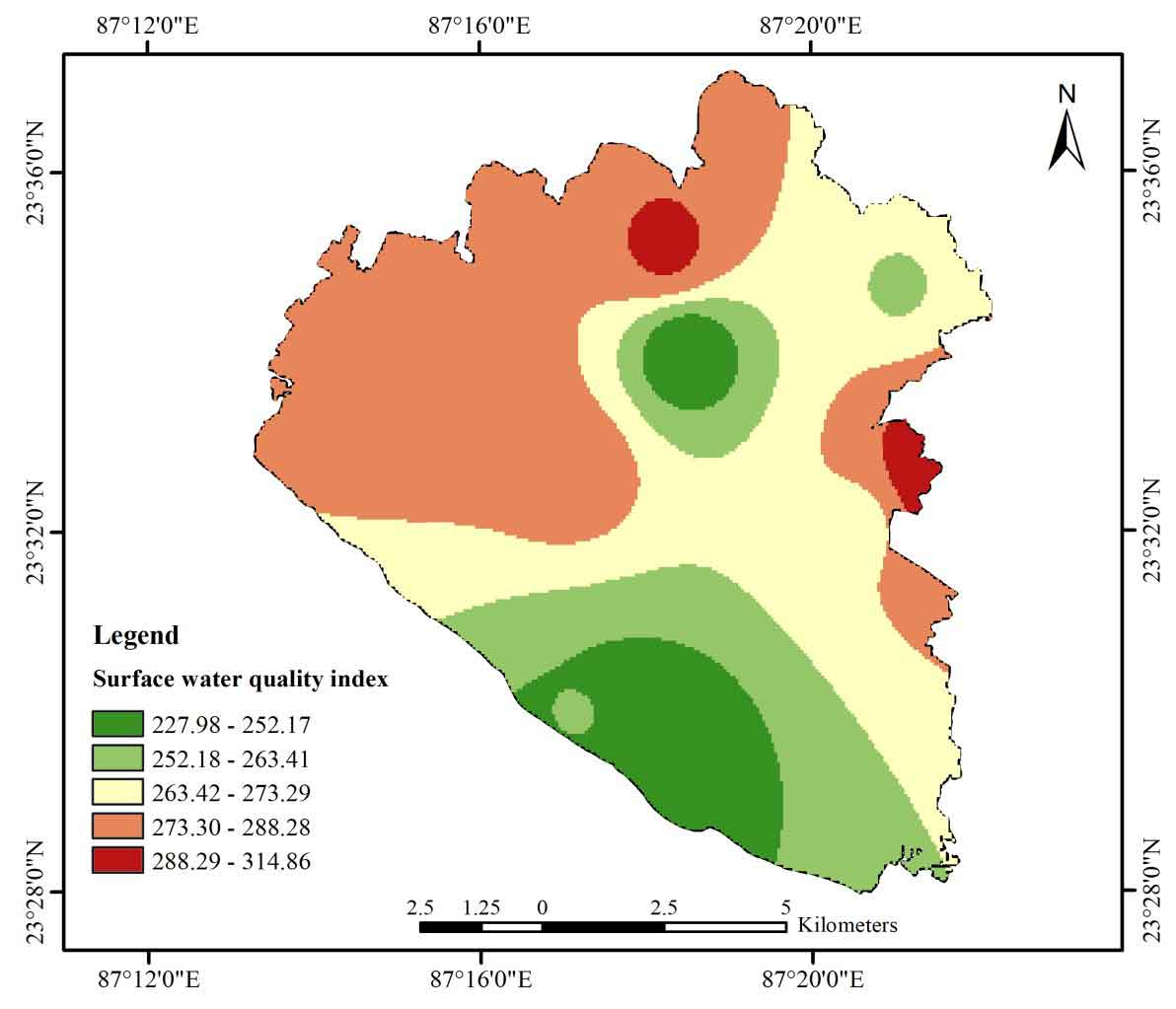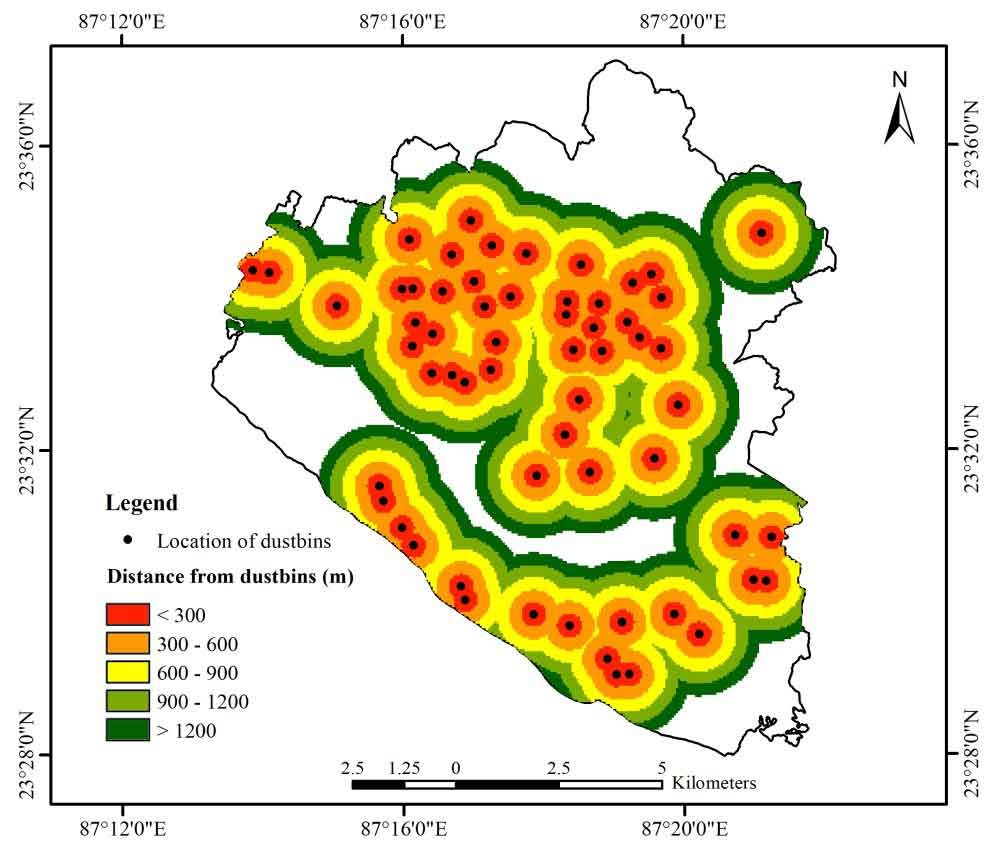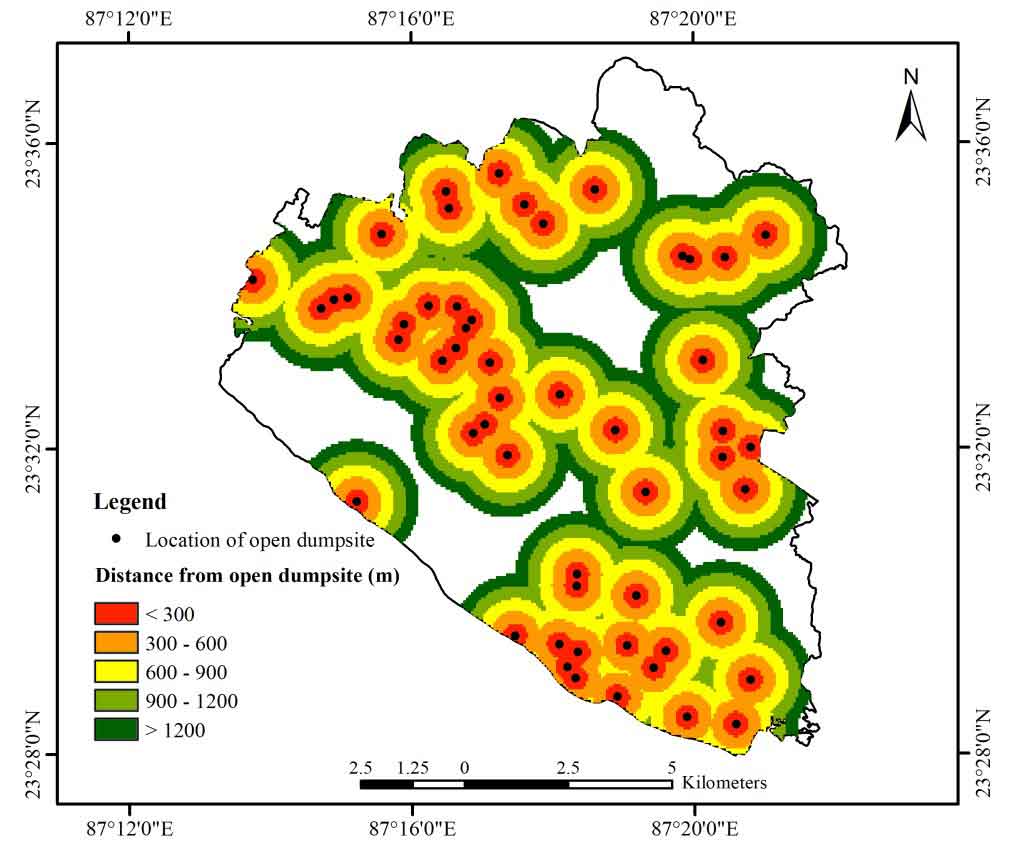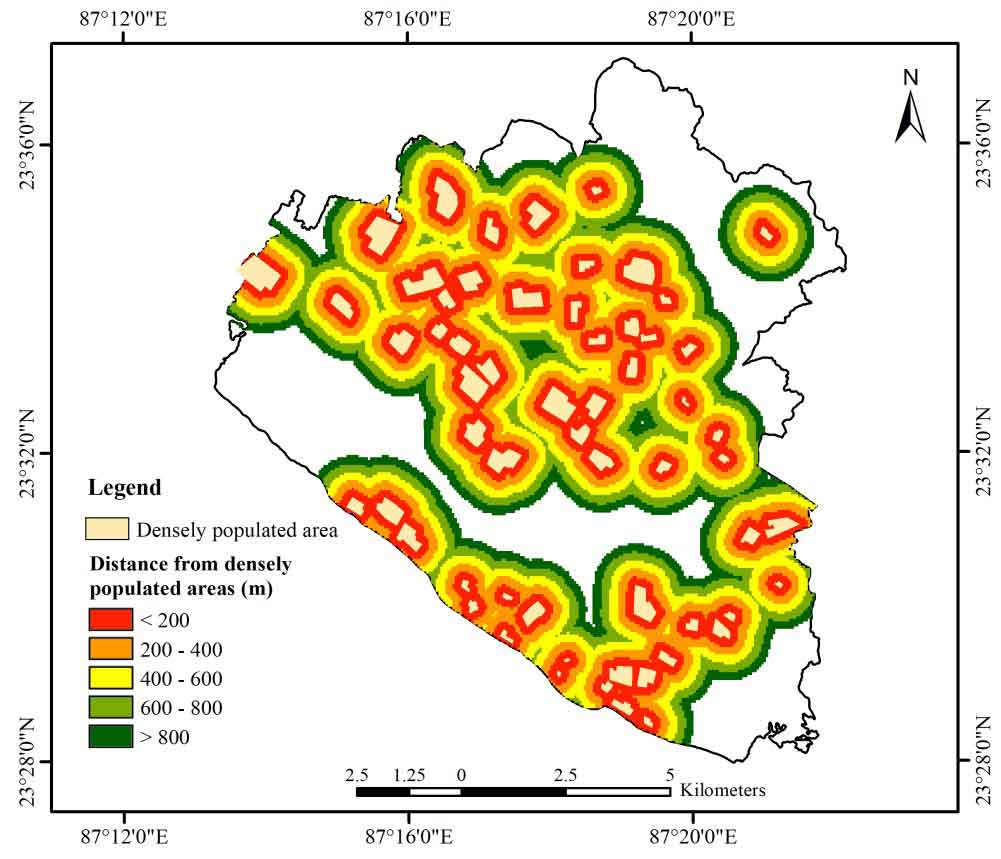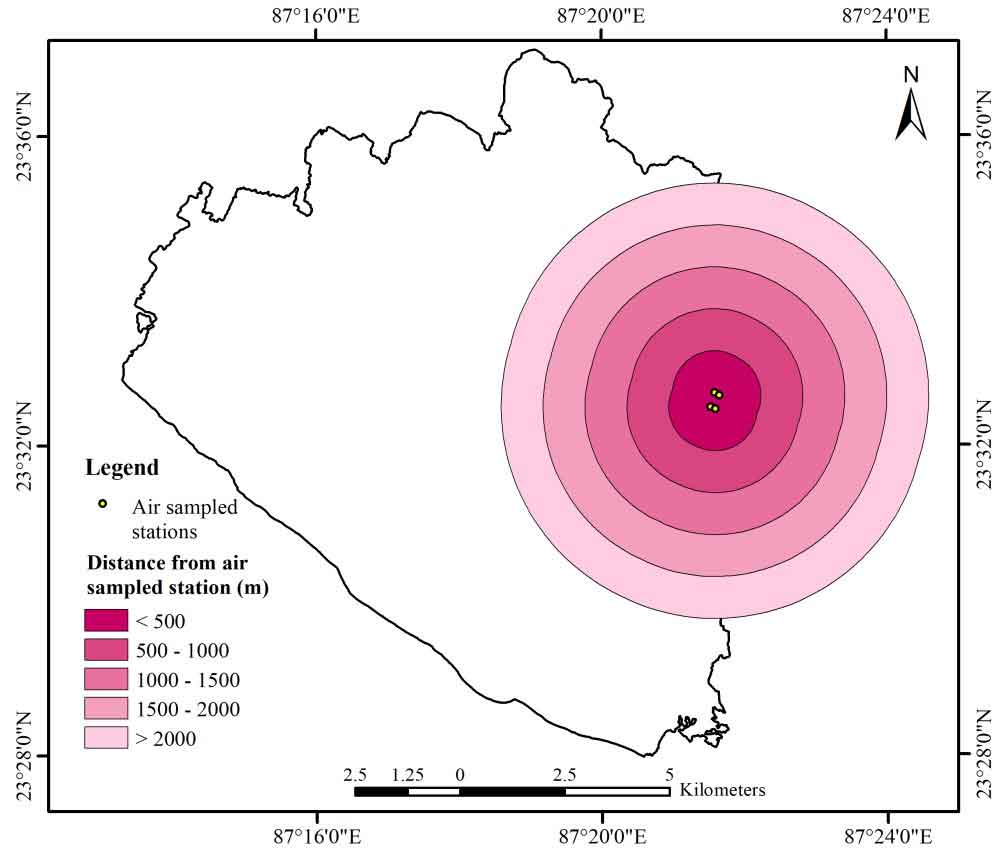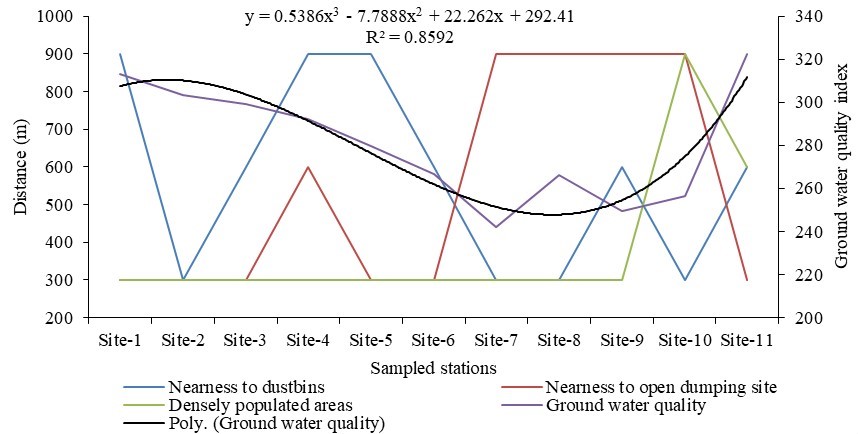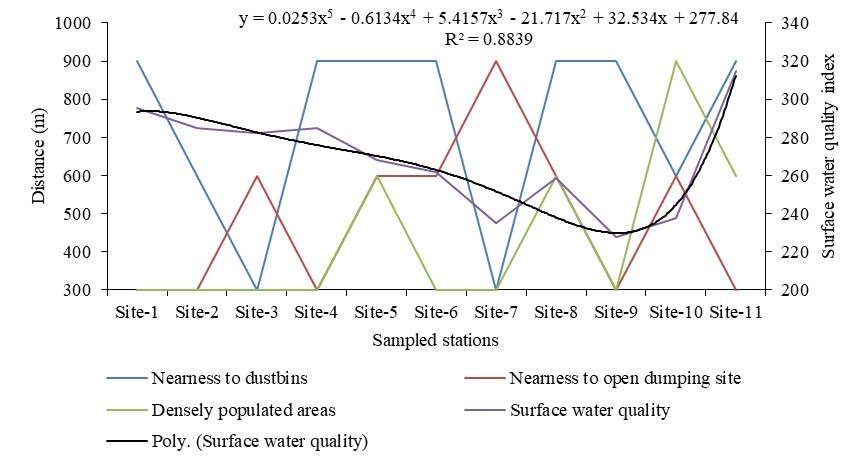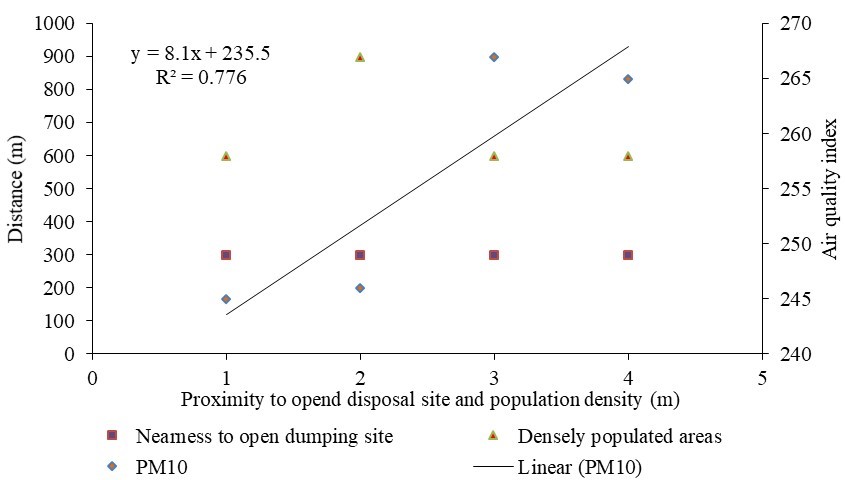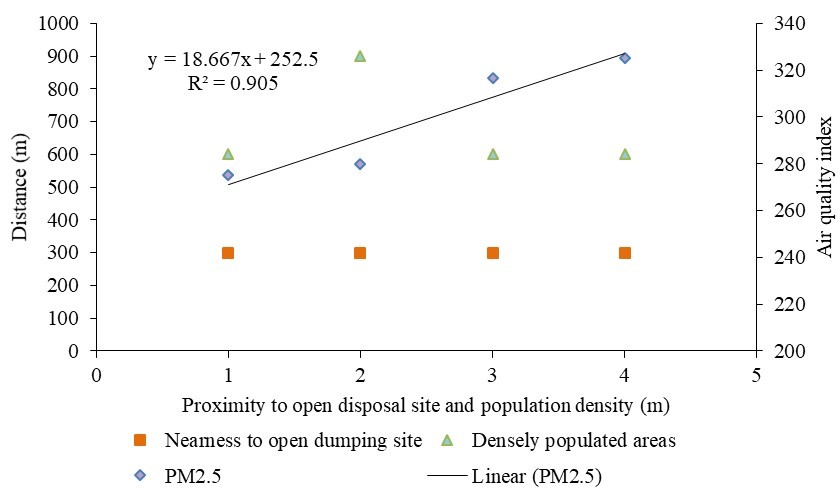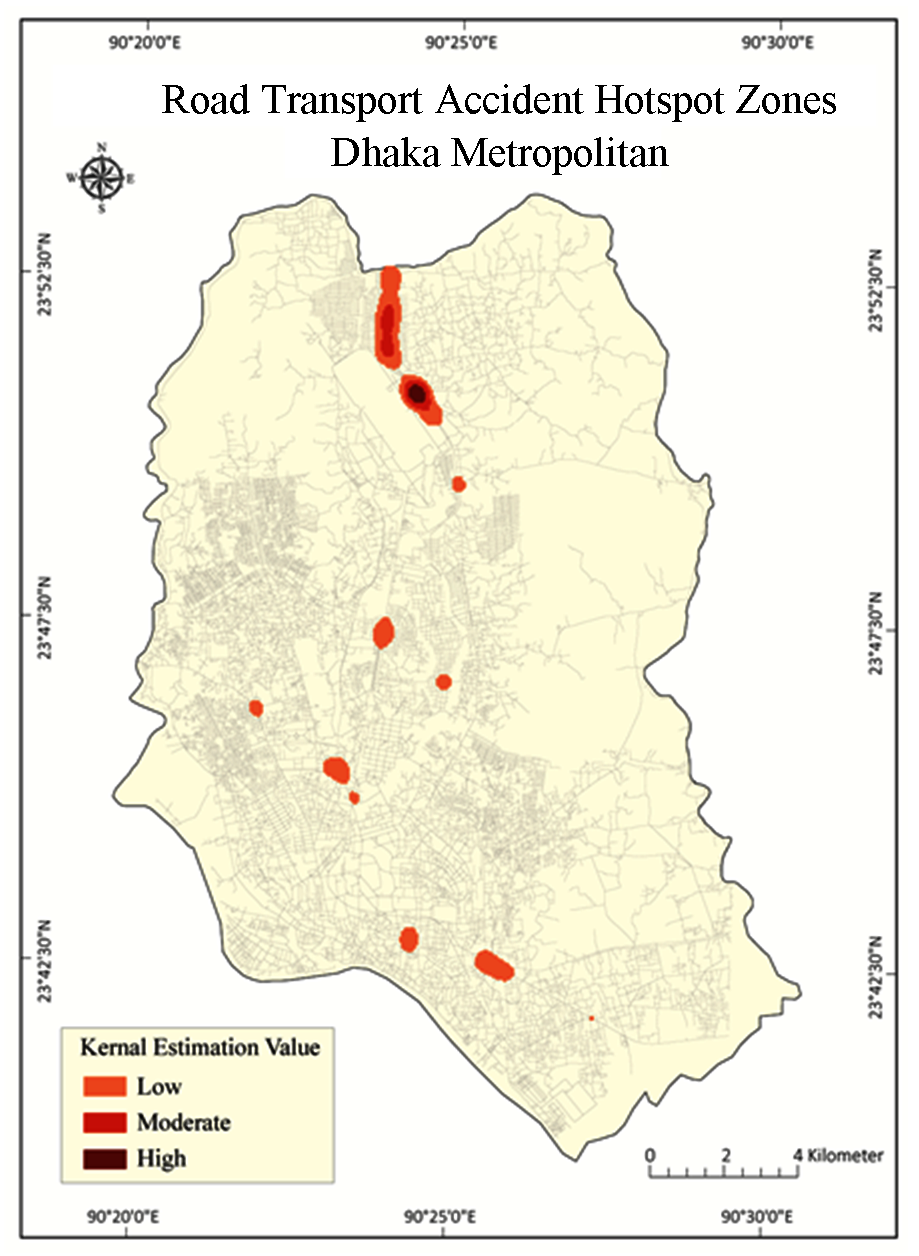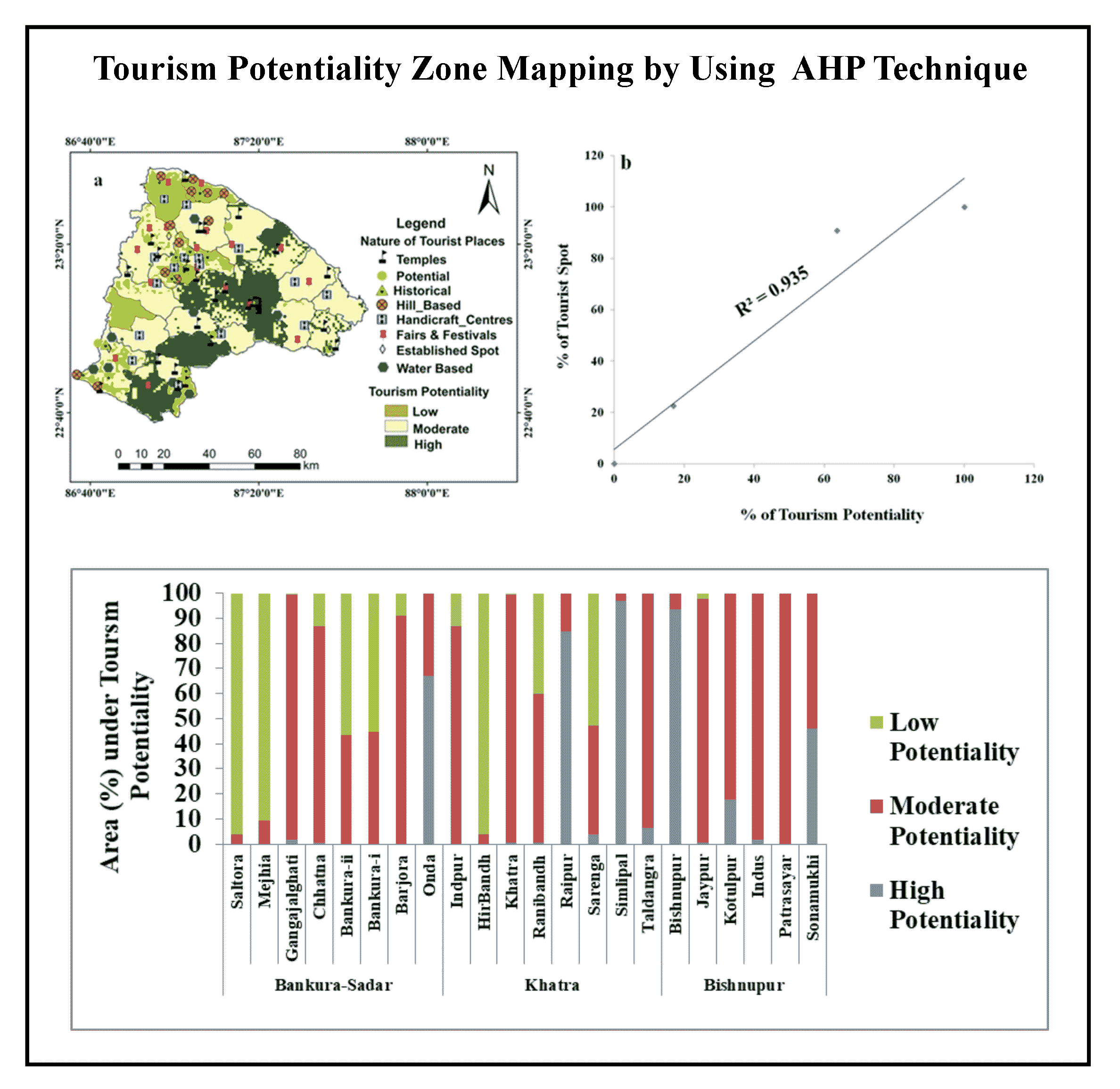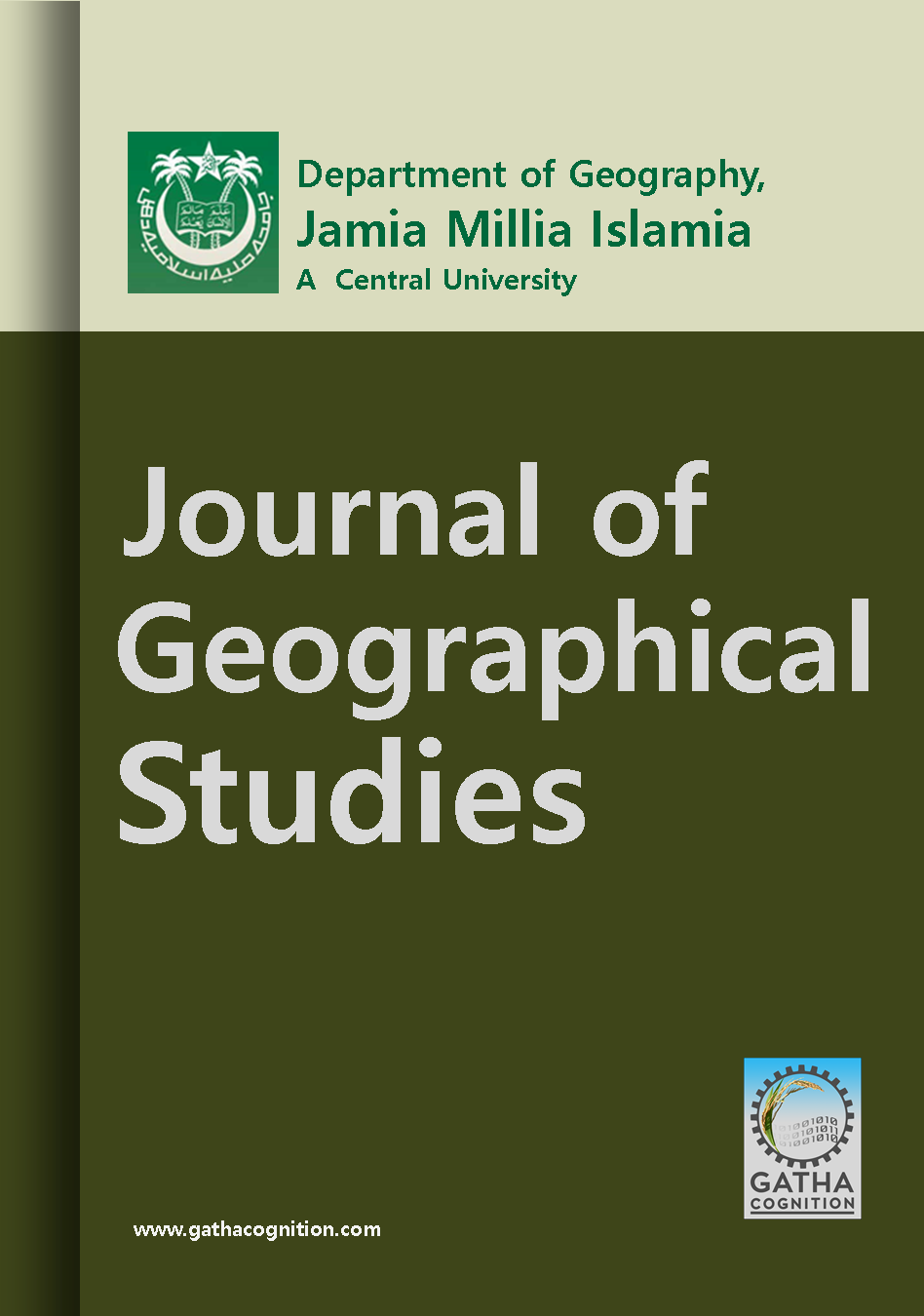3.1 Improper Solid Waste Disposal and Groundwater Contamination
3.1.1 Assessment of Groundwater Quality
The groundwater quality reveals significant variations in chemical parameters, with values near or exceeding BIS standards, particularly in areas close to dumping sites (Table 6). The mean values of each parameter of groundwater for pre-monsoon and post-monsoon seasons are shown in Table 6. The measured values of each parameter have been compared with the standards given by the BIS (IS 10500:2012) (Table 7). It has been found that the pH values at most locations are within BIS’s permissible range, however, Raghunathpur (8.7 mg/lit), near the final dump site (8.8 mg/lit), and Main gate (8.5 mg/lit) show slightly higher levels. The electrical conductivity (EC) ranges between 1335 μS/cm and 1808 μS/cm, with higher values near the dump site. Similarly, Total Dissolved Solids (TDS) concentrations, while within BIS’s upper permissible limit of 2000 mg/l, exceed the acceptable threshold of 500 mg/l, particularly near dumping areas. Total hardness levels across most locations surpass the acceptable BIS limit of 200 mg/l, reaching as high as 735 mg/l near waste areas. However, they remain under the permissible upper limit of 600 mg/l, with lower values observed further from dumping sites. Chloride concentrations are within BIS limits but range from 365.78 mg/l to 552.4 mg/l, with higher values closer to the dumpsite. Sulphate levels, on the other hand, are within safe limits at all locations, ranging from 17.5 mg/l to 28.8 mg/l.
COD values across all sampled locations range between 15 mg/l and 26 mg/l, indicating acceptable but slightly higher levels near the final dump site, likely due to organic waste. BOD levels, with a range of 0.16 mg/l to 0.32 mg/l, are within BIS standards but display similar trends of higher concentrations in proximity to waste areas. Phosphate concentrations, although minimal (0.14 mg/l to 0.27 mg/l), remain within safe drinking standards but are slightly higher near the dump. Ammoniacal nitrogen values range between 0.12 mg/l and 0.26 mg/l with the highest values found near the dump site. Arsenic concentrations (0.007 mg/l to 0.019 mg/l) remain under BIS’s permissible limit of 0.05 mg/l but are higher near the waste areas. Chromium levels vary between 0.012 mg/l and 0.025 mg/l, below the permissible limit of 0.05 mg/l, yet elevated values near dumping areas. Heavy metal contamination is most concerning, with cadmium levels ranging from 0.05 mg/l to 0.15 mg/l, significantly exceeding the BIS acceptable limit of 0.003 mg/l at all locations, especially near waste disposal sites. Mercury concentrations between 0.13 mg/l and 0.26 mg/l also exceed the BIS limit of 0.001 mg/l particularly around the dump. Lead levels (0.031 mg/l to 0.057 mg/l) likewise surpass the acceptable BIS limit of 0.01 mg/l, with the highest concentrations near the final dumping site.
Table 6. Measured values of physicochemical parameters (groundwater)
|
Sampled stations
|
pH
|
EC
|
TDS
|
TH
|
COD
|
BOD5
|
Cl-
|
PO43−
|
SO42−
|
NH4+-N
|
As
|
Cd
|
Cr
|
Hg
|
Pb
|
|
Raghunathpur
|
8.7
|
1762
|
1345
|
720
|
24
|
0.3
|
548.5
|
0.26
|
28.3
|
0.24
|
0.017
|
0.14
|
0.023
|
0.25
|
0.056
|
|
Main gate
|
8.5
|
1705
|
1315
|
690
|
22
|
0.28
|
522.45
|
0.24
|
27.5
|
0.22
|
0.015
|
0.12
|
0.021
|
0.23
|
0.053
|
|
Natun pally Punjabi para
|
8.3
|
1658
|
1305
|
685
|
21
|
0.26
|
522.25
|
0.22
|
26.2
|
0.2
|
0.014
|
0.11
|
0.02
|
0.22
|
0.052
|
|
Vidyasagar Primary Vidyalaya
|
8.1
|
1635
|
1265
|
660
|
20
|
0.25
|
515.75
|
0.2
|
25.8
|
0.19
|
0.012
|
0.1
|
0.018
|
0.19
|
0.047
|
|
Jharna pally
|
7.9
|
1575
|
1225
|
625
|
19
|
0.24
|
465.8
|
0.19
|
23.8
|
0.17
|
0.011
|
0.09
|
0.017
|
0.18
|
0.044
|
|
Bijra
|
7.5
|
1505
|
1180
|
600
|
18
|
0.22
|
421.3
|
0.17
|
22.8
|
0.15
|
0.008
|
0.07
|
0.014
|
0.16
|
0.038
|
|
Ispat nagari free Primary school
|
7.1
|
1335
|
1105
|
540
|
16
|
0.16
|
365.78
|
0.14
|
18.9
|
0.12
|
0.007
|
0.05
|
0.012
|
0.14
|
0.032
|
|
Raturiya
|
7.5
|
1545
|
1165
|
585
|
18
|
0.2
|
412.65
|
0.17
|
21.5
|
0.15
|
0.009
|
0.09
|
0.016
|
0.16
|
0.04
|
|
DPL coke oven Colony
|
7.1
|
1405
|
1130
|
545
|
15
|
0.19
|
375.44
|
0.15
|
17.5
|
0.13
|
0.008
|
0.06
|
0.015
|
0.13
|
0.031
|
|
Khejurtala
|
7.3
|
1445
|
1165
|
550
|
17
|
0.2
|
388.66
|
0.18
|
19.7
|
0.14
|
0.009
|
0.07
|
0.014
|
0.14
|
0.037
|
|
Near final Dumping site
|
8.8
|
1808
|
1400
|
735
|
26
|
0.32
|
552.4
|
0.27
|
28.8
|
0.26
|
0.019
|
0.15
|
0.025
|
0.26
|
0.057
|
Source: Based on field survey, the samples tested by the Environmental Laboratory of A.M.U., Aligarh, 2022.
Note: 1. EC- Electrical Conductivity, TDS- Total Dissolved Solid, TH-Total Hardness, COD- Chemical Oxygen Demand, BOD5- Biochemical Oxygen Demand, Cl-Chloride, PO43− -Phosphate, (SO42−) - Sulphate, NH4+-N-Ammoniacal nitrogen, As- Arsenic, Cd- Cadmium, Cr- Chromium, Hg- Mercury, Pb- Lead. 2. (All units are in mg/l except EC- μS/cm.)
Table 7. Drinking Water Quality Standards as per IS 10500:2012 (India)
|
Parameter
|
Acceptable Limit
|
Maximum Permissible Limit
|
Test Method Reference
|
Potential Health/Usage Effects Beyond Limits
|
|
pH
|
6.5–8.5
|
No relaxation
|
IS 3025 (Part 11)
|
Can harm mucous membranes and water supply systems
|
|
Turbidity (NTU)
|
1
|
5
|
IS 3025 (Part 10)
|
Reduced consumer acceptance above 5 NTU
|
|
Odour
|
Agreeable
|
Agreeable
|
IS 3025 (Part 5)
|
–
|
|
Total Dissolved Solids (TDS)
|
500
|
2,000
|
IS 3025 (Part 16)
|
May cause gastrointestinal irritation
|
|
Electrical Conductivity
|
–
|
–
|
–
|
–
|
|
Total Hardness (TH)
|
200
|
600
|
IS 3025 (Part 21)
|
Negative impact on domestic use
|
|
Chloride (Cl⁻)
|
250
|
1,000
|
IS 3025 (Part 32)
|
Affects taste, causes corrosion
|
|
Sulphate (SO₄²⁻)
|
200
|
400
|
IS 3025 (Part 24)
|
Gastrointestinal issues (with Mg/Na presence)
|
|
Ammoniacal Nitrogen (NH₄⁺-N)
|
0.5
|
No relaxation
|
IS 10500
|
–
|
|
Iron (Fe)
|
0.3
|
No relaxation
|
IS 3025 (Part 53)
|
Alters taste/appearance; impacts domestic use
|
|
Manganese (Mn)
|
0.1
|
0.3
|
IS 3025 (Part 59)
|
Affects taste/appearance; domestic issues
|
|
Zinc (Zn)
|
5
|
15
|
IS 3025 (Part 49)
|
Causes astringent taste and water opalescence
|
|
Fluoride (F⁻)
|
1
|
1.5
|
IS 3025 (Part 60)
|
Excess leads to fluorosis
|
|
Sulphide (H₂S)
|
0.05
|
No relaxation
|
IS 3025 (Part 29)
|
–
|
|
Arsenic (As)
|
0.01
|
0.05
|
IS 3025 (Part 37)
|
Toxic at higher concentrations
|
|
Cadmium (Cd)
|
0.003
|
No relaxation
|
IS 3025 (Part 41)
|
Toxic
|
|
Mercury (Hg)
|
0.001
|
IS 3025 (Part 48)
|
Toxic
|
|
Lead (Pb)
|
0.01
|
IS 3025 (Part 47)
|
Toxic
|
|
Chromium (Cr)
|
0.05
|
IS 3025 (Part 52)
|
Carcinogenic potential
|
|
Nickel (Ni)
|
0.02
|
IS 3025 (Part 54)
|
–
|
|
Cyanide (CN⁻)
|
0.05
|
IS 3025 (Part 27)
|
Toxic
|
|
Chloroform
|
0.2
|
APHA 6232
|
–
|
Source: Researcher’s compilation based on IS 10500:2012 standards.
Note: All units are in mg/l, max. - Not available
3.1.2 Assessment of water quality index
In this study, groundwater quality index has been calculated as per the standard value of BIS, 2012. The status of groundwater and classification of water quality in WQI has been presented in Table 8 and Table 9. Table 8 shows that the quality of groundwater in 4 sampled stations out of total 11 stations named Raghunathpur, Main Gate, Natun Pally Punjabi Para and near-final dumping site exceeds the value of more than 294 which is unfit for drinking purpose. The water qualities in these places have been highly deteriorated due to heavy absorption of pollutants discharged from nearby solid waste dumping sites. There is an immediate need for water treatment for these places before uses.
The status of water quality in 1 sampled station Vidyasagar Primary Vidyalaya is very poor, which is considered only for restricted use in irrigation. The people in Bijra predominantly use the well water for drinking, bathing and other domestic activities. The quality of water in this place has been highly contaminated with heavy pollutants and has been considered as poor status as per the WQI (Figure 5).
The status of groundwater quality of only two sampled stations named Ispat Nagari Free Primary school and DPL Coke Oven Colony range from 241 to 255 have been considered as good which is fit for domestic, irrigation and industrial activities but not for drinking (Table 9). There is not a single groundwater sampled station which is suitable for drinking purposes in the study area, but majority of the people in ward numbers 1 and 2 uses well water for drinking purposes.
3.2 Improper Solid Waste Disposal and Surface Water Contamination
3.2.1 Analysis of surface water quality
The physico-chemical parameters of the analyzed surface water samples of Durgapur city, including statistical mean values of pre-monsoon and post-monsoon seasons, are presented in Table 10. Fifteen parameters of surface water have been selected for the analysis of the quality of sampled surface water bodies in the study area (Table 11). The measured values of each parameter of water have been compared with the standards given by BIS-2012 (Table 10).
The surface water quality analysis of the sampled locations reveals notable variations across key chemical parameters, with certain values approaching or exceeding BIS standards, particularly near waste dumping sites. Most sampled sites exhibit pH levels within the BIS range (6.5-8.5); however, one site near the final dump shows a higher pH of 8.7, indicating minor alkalinity likely due to waste leaching. The EC values range from 1710 to 2110 μS/cm, with maximum concentration found near the final dumping site, suggesting increased dissolved ions from contaminants. Total Dissolved Solids (TDS) levels remain within BIS’s permissible range of 500-2000 mg/l, though highest near the dumping area, indicating salinity and potential leachate influence.
Table 8. Ground water quality index
|
Stations
|
|
GWQI
|
|
Raghunathpur
|
|
313.16
|
|
Main gate
|
|
303.43
|
|
Natun Pally Punjabi Para
|
|
299.25
|
|
Vidyasagar Primary Vidyalaya
|
|
292.04
|
|
Jharna Pally
|
|
279.43
|
|
Bijra
|
|
266.69
|
|
Ispat Nagari Free Primary School
|
|
242.20
|
|
Raturiya
|
|
266.10
|
|
DPL Coke Oven Colony
|
|
249.52
|
|
Khejurtala
|
|
256.59
|
|
Near Final Dumping site
|
|
322.49
|
Source: Calculated by the researcher, 2022.
Table 9. Classification of Groundwater Quality Based on WQI
|
No.
|
Water Quality Index (WQI) Range
|
Quality Status
|
Recommended Applications
|
|
1
|
Below 241
|
Excellent
|
Potable use, agricultural, and industrial
|
|
2
|
241 – 255
|
Good
|
Household, farming, and industrial purposes
|
|
3
|
255 – 268
|
Moderate
|
Suitable for irrigation and industrial use
|
|
4
|
268 – 281
|
Poor
|
Limited to irrigation only
|
|
5
|
281 – 294
|
Very Poor
|
Highly restricted irrigation use
|
|
6
|
Above 294
|
Unsuitable
|
Requires treatment before any application
|
Source: Research findings, 2022.
Table 10. Measured values of physicochemical parameters (surface water)
|
Name
|
pH
|
EC
|
TDS
|
TH
|
COD
|
BOD5
|
Cl-
|
P043-
|
S042-
|
NH4+-N
|
As
|
Cd
|
Cr
|
Hg
|
Pb
|
|
Near Raghunathpur
|
8.2
|
1964
|
1568
|
744
|
91.34
|
27.22
|
291.65
|
1.313
|
167.25
|
0.605
|
0.0066
|
0.07
|
0.067
|
0.083
|
0.117
|
|
Near Kada Road
|
8.4
|
1922
|
1504
|
703
|
87.32
|
26.54
|
284.55
|
1.222
|
162.3
|
0.588
|
0.0064
|
0.068
|
0.064
|
0.081
|
0.112
|
|
Natun Pally Near Punjabi Para
|
8.3
|
1932
|
1498
|
707
|
81.63
|
25.37
|
257.63
|
0.988
|
156.3
|
0.567
|
0.0057
|
0.062
|
0.062
|
0.075
|
0.101
|
|
Near Anandpausi Co-op.
|
8.2
|
1928
|
1478
|
702
|
78.35
|
25.05
|
255.65
|
0.967
|
145.38
|
0.532
|
0.0049
|
0.054
|
0.053
|
0.072
|
0.096
|
|
Near Fuljore
|
8
|
1845
|
1421
|
677
|
75.43
|
24.38
|
252.45
|
0.878
|
134.5
|
0.511
|
0.0045
|
0.043
|
0.047
|
0.067
|
0.092
|
|
Bijra Bandh
|
6.8
|
1825
|
1400
|
622
|
74.95
|
21.85
|
248.54
|
0.827
|
128.1
|
0.412
|
0.0039
|
0.041
|
0.043
|
0.061
|
0.09
|
|
Near Ispat Free Primary School
|
6.7
|
1710
|
1255
|
525
|
63.66
|
18.32
|
213.16
|
0.678
|
109.5
|
0.363
|
0.0028
|
0.028
|
0.032
|
0.042
|
0.076
|
|
Near DCL Colony
|
7
|
1805
|
1388
|
605
|
68.73
|
19.23
|
244.45
|
0.766
|
129.2
|
0.405
|
0.0033
|
0.033
|
0.038
|
0.056
|
0.082
|
|
Near Ashis Nagar Colony
|
6.1
|
1605
|
1216
|
522
|
62.57
|
18.55
|
221.69
|
0.723
|
113.4
|
0.352
|
0.0024
|
0.027
|
0.032
|
0.041
|
0.068
|
|
Near Khejurtala
|
6.6
|
1715
|
1245
|
535
|
65.64
|
19.12
|
243.44
|
0.812
|
119.5
|
0.344
|
0.0028
|
0.035
|
0.033
|
0.036
|
0.077
|
|
Near Final Dumping site
|
8.7
|
2110
|
1670
|
760
|
93.3
|
27.92
|
318.23
|
1.341
|
185.4
|
0.621
|
0.007
|
0.071
|
0.068
|
0.086
|
0.121
|
Source: Based on field survey, the samples tested by the Environmental Laboratory of A.M.U., Aligarh, 2022.
Note: All units are in mg/l, max. except EC–μS/cm.
Table 11. Standards for Surface Water Quality (BIS-2012)
|
No.
|
Parameter
|
Inland Surface Water
|
Public Sewers
|
Irrigation Use
|
|
1
|
pH Level
|
5.5 – 9.0
|
5.5 – 9.0
|
5.5 – 9.0
|
|
2
|
Total Suspended Solids (TSS, mg/L)
|
100
|
600
|
200
|
|
3
|
Temperature (°C)
|
≤ 5°C above ambient
|
Not specified
|
Not specified
|
|
4
|
Residual Chlorine (mg/L)
|
1
|
Not specified
|
Not specified
|
|
5
|
Ammonical Nitrogen (as N, mg/L)
|
50
|
50
|
Not specified
|
|
6
|
Total Nitrogen (as N, mg/L)
|
100
|
Not specified
|
Not specified
|
|
7
|
Free Ammonia (as NH₃, mg/L)
|
5
|
Not specified
|
Not specified
|
|
8
|
BOD₅ (mg/L)
|
30
|
350
|
100
|
|
9
|
COD (mg/L)
|
250
|
Not specified
|
Not specified
|
|
10
|
Arsenic (as As, mg/L)
|
0.2
|
0.2
|
0.2
|
|
11
|
Mercury (as Hg, mg/L)
|
0.01
|
0.01
|
Not specified
|
|
12
|
Lead (as Pb, mg/L)
|
0.1
|
0.1
|
Not specified
|
|
13
|
Cadmium (as Cd, mg/L)
|
2
|
1
|
Not specified
|
|
14
|
Total Chromium (as Cr, mg/L)
|
2
|
2
|
Not specified
|
|
15
|
Copper (as Cu, mg/L)
|
3
|
3
|
Not specified
|
|
16
|
Zinc (as Zn, mg/L)
|
5
|
15
|
Not specified
|
|
17
|
Fluoride (as F, mg/L)
|
2
|
15
|
Not specified
|
|
18
|
Sulphide (as S, mg/L)
|
2
|
Not specified
|
Not specified
|
|
19
|
Iron (as Fe, mg/L)
|
3
|
3
|
3
|
Source: Prepared by the researcher based on IS: 2012.
Total hardness values range from 522 to 760 mg/l, exceeding the BIS acceptable limit of 200 mg/l but falling within the upper permissible limit of 600 mg/l in most locations, with hardness generally higher near the final dumping site. COD and BOD levels remain within permissible ranges, yet display slightly elevated concentrations near the final dumping site, hinting at organic contamination. Chloride levels across sampled sites are within BIS standards, though readings are highest near the dumpsite, highlighting potential contamination risks. Trace elements like arsenic, cadmium, and chromium are detected in concentrations below BIS thresholds, but mercury levels exceed safe limits across several sites, particularly near the final dumping site, suggesting bioaccumulative pollution from solid waste. Maximum lead concentrations are also noted at sites near the final dumping area, posing health risks, particularly for sensitive groups. In summary, the analysis points to significant pollutant influx in surface water near waste areas, requiring monitoring to mitigate health and ecological impacts.
3.2.2 Assessment of water quality index
Surface water quality index of the sampled stations was calculated considering the standard value of BIS, 2012. The status of surface water quality and classification of water quality in WQI are shown in Table 12 and 13, respectively. Considering the status of surface water quality of the sampled stations, SWQI was classified into six classes (Table 13). Table 12 shows that the quality of surface water in 2 sampled stations Raghunathpur, and Natun Pally Punjabi Para exceeds the value of more than 287 which has been considered as unsafe for any uses. Three stations viz. near Kada Road, Natun Pally near Punjabi Para and near Anandpausi Co-op. come under very poor status while another 3 sampled stations, i.e., near Fuljhore, Bijra Bandh and DCL colony ranging WQI from 257 to 272 come under the poor quality of water. The surface water quality in sampled stations near Ispat Free Primary School, Ashis Nagar Colony, and Khejurtala are considered as good quality of water. The water quality in these sampled stations is not much contaminated due to its distant location from open dumping sites (Figure 4).
3.3 Improper Solid Waste Disposal and Air Pollution
3.3.1 Analysis of ambient air quality
The status of ambient air quality of the sampled stations located in the vicinity of open dumping sites was analyzed for summer and winter seasons. The mean values of PM10, PM2.5, SO2, and NOx in Table 14 and 15, respectively. The stations for ambient air quality monitoring were fixed considering the direction of wind flow in the area. The general wind direction during summer seasons is from south to north and from north to south during the winter season. Considering the locations of solid waste dumping site, two sampled stations were selected in the windward side and two stations on leeward side of the wind flow. The monitoring of AAQ was carried out as per the standard procedure. The details of the methodology for assessing air quality are presented in Table 4. The ambient air quality status around the landfill site was analyzed as per the Standards of Ambient Quality for landfills sites as suggested by MSW Rules 2016, MoEF, GoI (Table 16).
Tables 14 and 15 present the concentration levels of SO₂, NOₓ, PM₁₀, and PM₂.₅ across four stations near the dumping site during both summer and winter. It is found that SO₂ concentrations range from 15.1 to 18.4 μg/m³ in summer and 19.5 to 23.5 μg/m³ in winter, with the highest levels observed on the windward side of the sites. This variation is largely due to the combustion of sulfur-containing wastes like plastics and rubber. NOₓ concentrations vary from 15.2 to 19.2 μg/m³ in summer and 26.1 to 29.1 μg/m³ in winter. Both SO₂ and NOₓ levels remain within limits as specified by MSW Rules 2000, MoEF, Government of India.
Table 12. Sampled stations and surface water quality index
|
Stations
|
SWQI
|
|
Near Raghunathpur
|
295.46
|
|
Near Kada Road
|
285.10
|
|
Natun Pally Near Punjabi Para
|
282.47
|
|
Near Anandpausi Co-op.
|
285.10
|
|
Near Fuljore
|
267.97
|
|
Bijra Bandh
|
261.84
|
|
Near Ispat Free Primary School
|
235.18
|
|
Near DCL Colony
|
258.51
|
|
Near Ashis Nagar Colony
|
227.89
|
|
Near Khejurtala
|
237.99
|
|
Near Final Dumping Site
|
314.88
|
Source: Calculated by the researcher, 2022.
Table 13: Surface water quality index and status
|
Sl. No.
|
WQI
|
Status
|
|
1
|
< 227
|
Excellent
|
|
2
|
227 – 242
|
Good
|
|
3
|
242 – 257
|
Fair
|
|
4
|
257 – 272
|
Poor
|
|
5
|
272 – 287
|
Very Poor
|
|
6
|
> 287
|
Unsafe for using
|
Source: Calculated by the researcher, 2022.
Table 14. Air quality status of sampled stations (summer season)
|
Stations
|
Locations
|
Longitude
|
Latitude
|
Wind direction
|
PM10
|
PM2.5
|
SO2
|
NOx
|
|
1
|
North of Landfill site1
|
87°21'34.75"E
|
23°32'40.50"N
|
Windward
|
233
|
84
|
18.2
|
19.2
|
|
2
|
North of landfill site2
|
87°21'38.55"E
|
23°32'38.37"N
|
Windward
|
230
|
81
|
18.4
|
19
|
|
3
|
South of landfill site1
|
87°21'31.44"E
|
23°32'29.54"N
|
Downward
|
210
|
57
|
15.5
|
15.2
|
|
4
|
South of landfill site2
|
87°21'35.26"E
|
23°32'27.90"N
|
Downward
|
208
|
61
|
15.1
|
15.5
|
Source: Calculation is based on the field survey and laboratory experiment, 2022.
Note: 1. SO2- Sulphur dioxide, NOx- Nitrogen dioxide, 2. all units are in μg/m3
Table 15. Air quality status of sampled stations (winter season)
|
Stations
|
Locations
|
Longitude
|
Latitude
|
Wind direction
|
PM10
|
PM2.5
|
SO2
|
NOx
|
|
1
|
North of Landfill site1
|
87°21'34.75"E
|
23°32'40.50"N
|
Downward
|
245
|
165
|
19.8
|
26.1
|
|
2
|
North of landfill site2
|
87°21'38.55"E
|
23°32'38.37"N
|
Downward
|
246
|
168
|
19.5
|
26.3
|
|
3
|
South of landfill site1
|
87°21'31.44"E
|
23°32'29.54"N
|
Windward
|
267
|
190
|
23.5
|
29.1
|
|
4
|
South of landfill site2
|
87°21'35.26"E
|
23°32'27.90"N
|
Windward
|
265
|
195
|
23.3
|
28.5
|
Source: Calculation is based on the field survey and laboratory experiment, 2022.
Note: 1. SO2- Sulphur dioxide, NOx- Nitrogen dioxide, 2. all units are in μg/m3
Table 16. Permissible Ambient Air Quality Levels for Landfill Sites
|
No.
|
Parameter
|
Allowable Limits
|
|
1
|
Sulphur dioxide (SO₂)
|
50 μg/m³ (Yearly average*), 80 μg/m³ (24-hour max**)
|
|
2
|
Nitrogen dioxide (NO₂)
|
40 μg/m³ (Yearly average*), 80 μg/m³ (24-hour max**)
|
|
3
|
Particulate matter (PM₁₀)
|
60 μg/m³ (Yearly average*), 100 μg/m³ (24-hour max**)
|
|
4
|
Particulate matter (PM₂.₅)
|
40 μg/m³ (Yearly average*), 60 μg/m³ (24-hour max**)
|
|
5
|
Carbon monoxide (CO)
|
1-hour max: 4 mg/m³, 8-hour max: 2 mg/m³
|
|
6
|
Ammonia (NH₃)
|
100 μg/m³ (Yearly average*), 400 μg/m³ (24-hour max**)
|
|
7
|
Benzo(a)pyrene (BaP) (particulate)
|
1 ng/m³ (Yearly average*)
|
Source: Developed by the author using guidelines from the Ambient Air Quality Standards for Landfills under the MSW Rules 2016, Ministry of Environment, Forest and Climate Change, Government of India. Note: The annual average values (*) are based on the arithmetic mean of at least 104 measurements taken twice per week over a year, while the 24-hour, 8-hour, or 1-hour maximum limits (**) must be met 98% of the time annually, allowing exceedances up to 2% of the time, provided they do not occur on two consecutive monitoring days.
Table 17. Ambient air quality status
|
Locations
|
Summer season
|
Winter season
|
|
PM10
|
PM2.5
|
SO2
|
NOx
|
PM10
|
PM2.5
|
SO2
|
NOx
|
|
North of Landfill site1
|
233.00
|
140.00
|
22.75
|
24.00
|
245.00
|
275.00
|
24.75
|
32.63
|
|
North of landfill site2
|
230.00
|
135.00
|
23.00
|
23.75
|
246.00
|
280.00
|
24.38
|
32.88
|
|
South of landfill site1
|
210.00
|
95.00
|
19.38
|
19.00
|
267.00
|
316.67
|
29.38
|
36.38
|
|
South of landfill site2
|
208.00
|
101.67
|
18.88
|
19.38
|
265.00
|
325.00
|
29.13
|
35.63
|
Source: Calculated by the researcher, 2022.
For particulate matter, PM₁₀ concentrations range from 208 to 233 μg/m³ in summer and 245 to 267 μg/m³ in winter, while PM₂.₅ levels are in between 57 and 84 μg/m³ in summer and 165 to 195 μg/m³ in winter. Higher concentrations in winter are attributed to poor air circulation. Although PM₁₀ exceeds regulatory limits at all stations, PM₂.₅ levels exceed standards at all stations except the southern station, downwind of the landfill.
3.3.2 Assessment of Air Quality Index (AQI)
The AQI was calculated following the method by Kaushik et al. (2006). The status of air quality index of the sampled stations for both summer and winter seasons is shown in Table 17. Table 17 shows that the values of SO2 and NOx in all the four sites remained within the acceptable limits. During the winter season, the values of SO2 and NOx were recorded higher than the summer season. But, the level of concentration of PM10and PM2.5 in all four stations during both summer and winter seasons were found to be exceeding the acceptable limits. The highest concentration of PM10 and PM2.5 is found in the south of landfill site-2 (windward) during the winter season which may affect the people living nearby the dumping site.
To further assess environmental impacts, spatial buffers were created around key pollution sources such as dustbins, open dumpsites, densely populated areas, and the Shankarpur landfill site. This helped in identifying zones affected by groundwater and surface water pollution, as well as air quality degradation (Figure 7, 8, 9 and 10). These buffer zones highlight regions at risk of groundwater, surface water, and ambient air pollution.
3.4 Environmental Impact Assessment of Improper Solid Waste Disposal
The environmental impact assessment of improper disposal of solid waste on surface water, groundwater, and the air was analyzed with help of standard statistical technique to find out the degree of correlation with improper management of solid waste and water and air. The correlation between groundwater quality and proximity to dustbins, open dumping sites, and densely populated areas is shown in Figure 11. The analysis reveals that nearness to dustbins, open dumping sites and densely populated areas are positively correlated with poor groundwater quality with R2 value 0.85. It is found that the groundwater quality is good in those sampled stations which are far away from open disposal sites, dustbins and low vulnerable areas to solid waste management.
Similar results are found in case of surface water quality and locations of dustbins, open dump sites and highly densely populated areas. Figure 12 illustrates the correlation between surface water quality and proximity to dustbins, open dumps, and densely populated areas with R2 value 0.88. It is found that the surface water quality is good in those sampled stations which are far away from open disposal sites, dustbins and low vulnerable areas to solid waste management and vice-versa.
Figure 12 and Figure 13 display the correlation between air quality (specifically PM₁₀ and PM₂.₅ levels) and proximity to open dumping sites and densely populated areas in both seasons. The results indicate that PM₁₀ and PM₂.₅ levels are significantly higher in winter, likely due to reduced air circulation, and exhibit a stronger correlation with waste disposal sites and high-density areas compared to summer levels.







